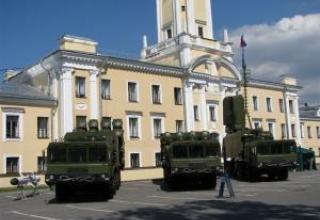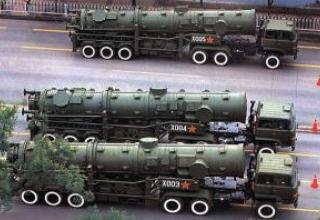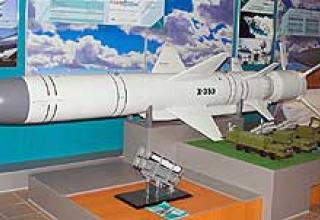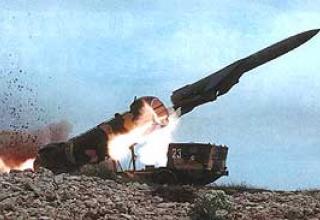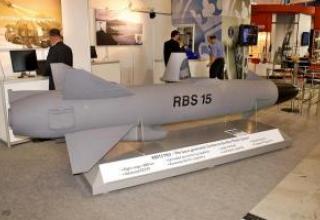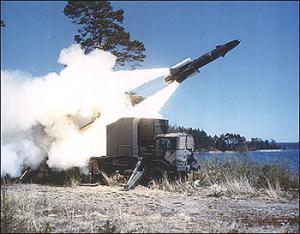
To fight against enemy surface ships in coastal waters Saab Missiles (Sweden) has developed a mobile coastal missile system (SLRK) RBS-15ka. It is designed to engage targets at ranges up to 100 km of medium and small displacement, as well as to disable individual systems on large ships.
The missile included in the complex is based on the all-weather anti-ship missile RBS-15 class "ship-to-ship", which is in service with the Navy of Sweden, Yugoslavia, Croatia, Finland and other countries. The RBS-15ka batteries are in service with the Swedish and Finnish coastal defence units.
At present, the Saab Missiles company offers the latest version of this RBS-15Mk3 missile with an extended range (up to 200 km), and a combined radar and passive infrared homing head, which dramatically increases its interference immunity and the probability of hitting the target in conditions of strong radio electronic countermeasures.
Composition:
RBS-15f missile is made according to the aerodynamic scheme "duck", has a cylindrical body, folding tail stabilizers and steering wheels. The missile is guided on the marching section of the trajectory by means of an inertial system with a radio altimeter, which provides its flight to the target in a straight line or programmed turning to the target at a predetermined point, as well as flying over obstacles (islands) that are on the trajectory between the starting position and the target. At the final point, the target is guided by the Philips Active Homing Radar (AHD), which operates in the 15.9-17.1 GHz frequency band. CNS has increased noise immunity, the width of its search area by azimuth ± 30 °, the angle of the place ± 15 °. The missile's electronic equipment also includes a built-in automatic SOS check unit.
The turbojet engine TRI-60-1-077 of French company "Microturbo" (length 695 mm, diameter 330 mm, weight 53 kg) running on JP-5 fuel is used as a marching engine. The rocket is launched with the help of launch accelerators, which operate for 3 seconds. The missile is equipped with a high-explosive warhead weighing 200 kg.
Battery RBS-15ka consists of six platoons: headquarters, control, two firing, security, repair and maintenance. The battery is equipped with a Strick BIOS and a 9KR 400 target detection and tracking radar. The total number of its personnel is 211. The fire platoon includes: a control section (in a two-axle van SL171), radar and three fire sections (one each with four missiles on a three-axle vehicle: the Swedish on the "Scania" 112N, Finnish - on the "Sisu"). A service platoon, branch or guard platoon is assigned to the Fire Platoon (20 men).
The launcher is a block of four containers with auxiliary equipment and a lifting mechanism providing an elevation angle of 22°. Four hydraulically driven stops are available for mounting the machine in the horizontal plane. The transport and starting containers are made of aluminium alloy. In order to reduce the container size, the rocket in it is rotated by 45°, so that the launch accelerators are located on its diagonal.
Transfer PU in a camping position after the launch of missiles to change the firing position takes about 5 minutes, and reload four new missiles - less than 1 h. The direction of missile launch may differ from the direction of the target to 90 °.
The firing control point is located in the truck van and is served by one officer and three operators. Target data are transmitted to the control station via digital radio channels for firing in the platoon control section. The PU located at a minimum distance of 500 m from the vehicle of the platoon control section are connected to the vehicle by a fiber optic cable. The starting unit can be located at a distance of up to 500 m from the firing control station.
The complex is characterized by rather high mobility, in particular, the total time of the RBS-15 at the starting position is about 5 minutes, which includes time to prepare for launching, firing and its coagulation. After the first missile is launched, the second one can be launched at a new target in 10 seconds.
The guard platoon consists of three infantry wards and a PTUR section. In the expected RBS-15 areas of use, shelters have been built in the rocks, where the PPs are located before receiving the deployment command and where they return after launch.
Characteristics:
| Range, km | 100 |
| The length of the rocket, mm | 4350 |
| The diameter of the rocket body, mm | 500 |
| Diameter with folded stabilizers, mm | 850 |
| Swing of stabilizers, mm | 1400 |
| Start weight (with two accelerators), kg | 770 |
| Weight of the rocket (without boosters), kg | 598 |
| Weight of combat unit, kg | 200 |
Testing:
As part of the UK's 12th Air Defence Regiment, Rapier SAMs participated in combat operations during the Falkland conflict in 1982. 12 launchers have been deployed since the first day of the English landing on the Falkland Islands. Sources from the English government (White Paper: The Falkland Campaign. Lessons) claim that 14 Argentine planes were destroyed by Rapier complexes. However, according to other information, the "Rapier" complex shot down only one AI Dogger A and participated in the destruction of the A-4C Skyhawk. The Blindfire radar did not participate in these hostilities.
The Rapier complex participated on the Iranian side in the war between Iran and Iraq in the 1970s, and is believed to have destroyed an Iraqi Tu-22 type bomber.
The "Rapier" SAM system was also deployed for the English multinational air defense contingent during Operation Desert Storm in 1991.
Sources:
- Мочалов Р. "Шведский береговой мобильный противокорабельный ракетный комплекс",Зарубежное военное обозрение,N 3,1988.
- Малышев В. "Средства береговой обороны и перспективы их развития", Зарубежное военное обозрение,N 3,2001.


